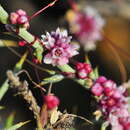en
names in breadcrumbs


This species is close to Cuscuta europaea, from which it is differentiated by having purple stems, sessile stamens and sepal lobes with reticulate venation and style 2.5-3 mm long. Different forms of this species described by Yuncker are not recognized here both because only a limited number of collections are available, and the characters used by Yuncker for the separation of different forms intergrade.
Cuscuta epithymum (dodder, lesser dodder, hellweed, strangle-tare) is a parasitic plant assigned to the family Cuscutaceae or Convolvulaceae, depending on the taxonomy. It is red-pigmented, not being photosynthetically active. It has a filiform habit, like a group of yarns. Its leaves are very small, like flakes. Its flowers, disposed in little glomerules, have a white corolla, with the androecium welded to the corolla.
In Eurasia, this species of dodder would often attach itself to the Conehead thyme (Thymus capitatus), taking on the plant's pungency and from whence it also derived its host's Arabic name, al-ṣaʿitrah.[6] During medieval times, dodder was often used as a medicinal cure in treating depression, but causes thirst and dryness of the mouth when consumed.[6]
Cuscuta epithymum (dodder, lesser dodder, hellweed, strangle-tare) is a parasitic plant assigned to the family Cuscutaceae or Convolvulaceae, depending on the taxonomy. It is red-pigmented, not being photosynthetically active. It has a filiform habit, like a group of yarns. Its leaves are very small, like flakes. Its flowers, disposed in little glomerules, have a white corolla, with the androecium welded to the corolla.
In Eurasia, this species of dodder would often attach itself to the Conehead thyme (Thymus capitatus), taking on the plant's pungency and from whence it also derived its host's Arabic name, al-ṣaʿitrah. During medieval times, dodder was often used as a medicinal cure in treating depression, but causes thirst and dryness of the mouth when consumed.